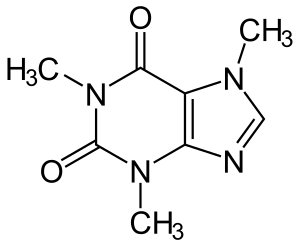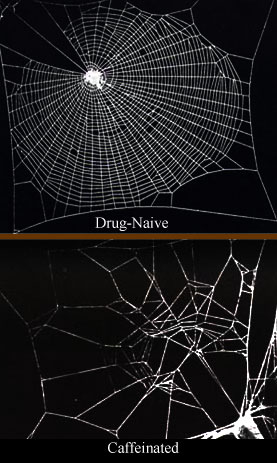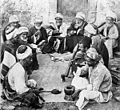Caffeine facts for kids
Caffeine is a natural chemical found in many plants. It acts like a mild drug because it changes how your body works. While many people enjoy drinks with caffeine, it can be harmful if you have too much. For example, drinking 80 to 100 cups of coffee very quickly could be deadly for a person.
Contents
Where Does Caffeine Come From?
Caffeine is most famous for being in coffee. Coffee comes from a tree, and the seeds of this tree are roasted to make the coffee we drink.
But coffee isn't the only plant with caffeine! You can also find it in plants like guarana, yerba maté, cacao (which is used to make chocolate), and some plants used for tea. Plants actually use caffeine as a pesticide. This means it's a natural chemical that helps protect the plant by harming insects that try to eat it. It's the plant's own way of staying safe!
What Caffeine Does to Your Body

Caffeine is known as a stimulant drug. A stimulant makes your body's actions speed up. This can include your heart rate, blood pressure, and how fast your body uses energy (your metabolism). Because of this, caffeine can make you feel more awake and alert.
Caffeine is also a diuretic. This means it makes your body produce more urine, which is the liquid waste your body gets rid of.
The chemical name for caffeine is a xanthine alkaloid. This is a group of chemicals that act as stimulants. Some chemicals in this group, like theophylline, are even used as medicine to help people with asthma breathe better.
How Caffeine Is Used
Most people use caffeine to help them stay awake and focused. That's why many people drink coffee or other caffeinated drinks, especially when they need to study or work.
Sometimes, doctors use caffeine as a medicine. It can help with headaches. It's also sometimes given to babies who are born very early (premature babies) to help them breathe.
Caffeine can also be given to people after a lumbar puncture. This is a test where doctors take a small sample of fluid from your spine to check for problems like meningitis.
Caffeine is also found in many over-the-counter medicines, like those for headaches or cramps. When caffeine is mixed with other pain relievers, it can help them work even better.
However, it's important to remember that caffeine can be risky if not used carefully.
Problems with Caffeine

One of the biggest problems with caffeine is that people can become addicted to it. This means your body gets used to having caffeine, and if you stop, you can feel bad. When people feel bad because they don't have caffeine, it's called withdrawal. To feel better, they might drink more caffeine. If they can't get it, they might feel symptoms like:
- Headache
- Feeling very tired or sleepy
- Feeling annoyed or easily upset
- Nausea (feeling like you might vomit)
Drinking too much caffeine at once can also be harmful. This is called an overdose. A caffeine overdose is a real medical problem. People who have too much caffeine can experience:
- Very strong bad feelings, such as:
- Muscle movements you can't control
- A very fast heart rate
- Unusual heart rhythms (your heart beating strangely, or even stopping)
- Very high blood pressure
- Vomiting
- Confusion (not knowing who you are or where you are)
How Much Caffeine Is Safe?
Having about 250–300 milligrams (mg) of caffeine a day is considered a moderate amount. This is roughly the amount of caffeine in three cups of coffee (if each cup is 8 ounces). Having more than 750–1000 mg a day is a lot, but it's very unlikely to be deadly for most people.
Caffeine is in many different foods and drinks. Here are some approximate amounts of caffeine you might find:
- Brewed coffee: 40 to 220 mg in one cup
- Instant coffee: 30 to 120 mg in one cup
- Decaffeinated coffee (most caffeine removed): 3 to 5 mg in one cup
- Tea: 20 to 110 mg in one cup
- Soda drinks with caffeine: 36 to 90 mg in a 12-ounce can. Some light-colored sodas also have caffeine, so color doesn't always tell you!
- Milk chocolate: 3 to 6 mg in one ounce
- Bittersweet chocolate: 25 mg in one ounce
Just so you know:
- One ounce (oz) is about 30 milliliters (ml).
- A "cup" usually means 8 oz (about 240 ml).
Different Ways to Get 200mg of Caffeine
| Caffeine Equivalents |
|---|
In general, each of the following has about 200 milligrams of caffeine:
|
Images for kids
-
Tiny, thread-like crystals of pure caffeine seen under a microscope.
-
A Coffeehouse in Palestine, around 1900.
-
How caffeine affects spider webs.
See also
 In Spanish: Cafeína para niños
In Spanish: Cafeína para niños









